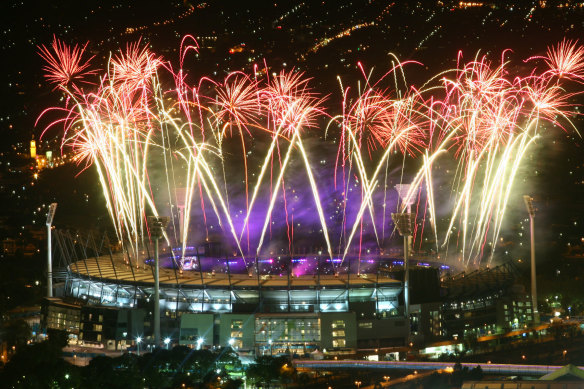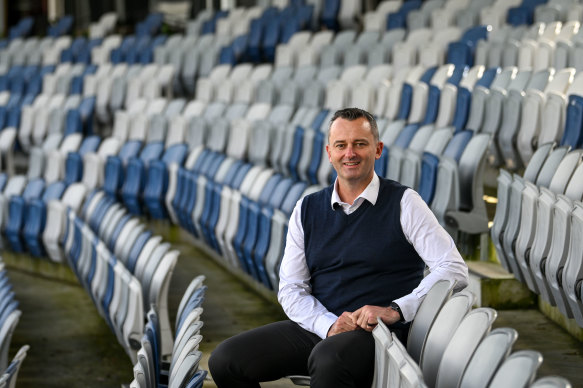Infrastructure crunch: Can Victoria be ready in time for the Games?

Key points
- The state government says the Commonwealth Games will contribute more than $3 billion to the economy, creating about 7500 jobs before, during and after the two-week event.
- But so far, there are few details about what infrastructure will be needed and where, with the state facing major shortages of labour and raw materials.
- Victoria is expected to require a workforce double the size available within its borders at various points over the next four years.
Victoria is heading for a serious infrastructure crunch in the coming two years as shortages of labour and raw materials threaten to collide with preparations for the Commonwealth Games.
The Andrews government says the Games will contribute more than $3 billion to the state’s economy, creating about 7500 jobs before, during and after the two-week event, due to be held in and around Geelong, Bendigo, Ballarat and Gippsland in March 2026.
Celebration or squeeze? Regional councils are concerned there won’t be time to complete necessary infrastructure before the 2026 Commonwealth Games.Credit:Penny Stephens
But business organisations and infrastructure experts are growing increasingly nervous about the tight timetable for the Games.
Regional councils have unveiled extensive wish lists of infrastructure they say will be needed to host events and accommodate huge spectator crowds, from new train stations and athletes’ villages to stadium upgrades.
But five months after Premier Daniel Andrews announced Victoria’s successful bid, there are few details about new facilities needed to handle an internationally significant event.
A spokeswoman said the government was “working hard alongside business leaders and local communities in the four regional hubs to identify sites for villages and to finalise the sport program”.
With Victoria’s infrastructure pipeline already stretched to the limits, the state’s capacity to deliver an extra $2.6 billion in Games infrastructure spending announced in the May budget will be tight.
According to the budget, total government infrastructure investment is expected to average $21.3 billion a year over the budget and forward estimates – more than four times the 10-year average to 2014-15.
This includes investments in health, housing, schools and transport, as well as mega-projects such as the North East Link, the Metro Tunnel, the West Gate Tunnel, the Melbourne Airport Rail and the Suburban Rail Loop.
Infrastructure Australia, the federal government’s chief major projects adviser, has warned that demand for labour needed to deliver infrastructure will hit “unprecedented levels” over the next three years.
Ballarat Mayor Daniel Moloney next to the location for a new train station opposite Mars Stadium.Credit:Eddie Jim
In a recent report, it said national labour shortages would be three times greater than in 2017-18, peaking at 105,000 roles by mid-2023, with demand for workers expected to be 48 per cent higher than supply.
It said Victoria, Queensland and Tasmania would face the biggest shortages. Alarmingly, Victoria is expected to require a workforce double the size available within its borders at various points over the next four years.
A report from Victoria’s new Skills Authority also warned the state was facing a shortage of 373,000 workers within three years, including 34,000 construction workers.
The cracks are already starting to show.
Late last year the Corangamite Shire released a tender for work on a “major revitalisation” of the Port Campbell township, near the Twelve Apostles. The $15.6 million budget included $5.6 million from the federal government and $6 million from Victoria.
The project did not attract a single bidder.
Corangamite mayor Ruth Gstrein said the project was now being broken down into smaller parts.
Gstrein said there was a severe shortage of construction workers and companies often submitted bids two or three times what the council had hoped to pay for infrastructure projects.
“That’s not just Corangamite. That’s across the board.”
Ballarat Mayor Daniel Moloney said he was confident the infrastructure required for the Games could be delivered in time but decisions needed to be made soon.
“The temporary infrastructure doesn’t worry us so much,” he said. “The bigger challenge is delivering the bigger infrastructure, particularly the athletes’ village.”
The council has an extensive list of projects required for the Games,including an athletes’ village accommodating 2000 people which will be converted into permanent housing and a third railway station providing access to Mars Stadium. It also wants to increase Mars Stadium’s permanent capacity from 12,000 to 20,000.
Ballarat Mayor Daniel Moloney at Mars Stadium.Credit:Eddie Jim
Moloney said Games preparations could affect the council’s ability to deliver other local infrastructure projects.
“The issue we’re giving some thought to right now is the capacity to do our own big builds at the same time the Commonwealth Games are happening.”
Regional Australia Institute chief economist Kim Houghton said many regional councils felt growing pressure to improve infrastructure because they had experienced greater growth than they had planned for before the pandemic.
“They’re struggling to keep up with the physical infrastructure as well as social services,” he said.
Houghton said local residential construction and infrastructure projects were now competing with big ticket items promised by the state government.
“There’s little doubt that the very large scale public construction spend that started a couple of years ago to stave off recession really is crowding out local building and construction.”
Infrastructure Partnerships Australia chief executive officer Adrian Dwyer said given the size of Australia’s infrastructure pipeline, the competition for people and resources was “inevitably fierce”.
“In Victoria alone, that major end of the pipeline is pushing $140 billion,” he said. “Having such a full pipeline is not unique to Victoria, with the national infrastructure workforce needing to grow by over a third between now and 2024.”
In a document canvassing requirements for the Commonwealth Games, the G21 Geelong Region Alliance also calls for substantial infrastructure upgrades.
“Geelong station is the gateway to the central city but in poor condition,” the document says. “It will need a major overhaul to receive the thousands of people arriving by train for the Games. At the moment amenity is woeful.”
Huge crowds are expected in Geelong, which will host swimming and diving, beach volleyball, gymnastics, hockey, table tennis and triathlon.
Alliance chief executive Giulia Baggio said people would need more public transport options for the Games.
“We can’t have all of them in cars,” she said.
Baggio said she was confident the Andrews government would deliver on its commitments for the Games but insisted the federal government needed to “re-orient its gaze” to Victoria.
“Canberra was looking north in previous years. We’d like them to look our way.”
Bendigo Council’s Commonwealth Games director Andrew Cooney said his regional city also needed additional train stations to support the event, as well as pedestrian paths to accommodate more foot traffic.
The council is also seeking an expansion for its art gallery following the success of its recent exhibition on Elvis Presley.
Cooney insisted the city could be ready for the Games despite the tight deadline. However, he conceded delivering infrastructure projects had become increasingly difficult.
“It’s certainly more challenging now than it was a couple of years ago,” he said.
The Morning Edition newsletter is our guide to the day’s most important and interesting stories, analysis and insights. Sign up here.
Most Viewed in National
From our partners
Source: Read Full Article


